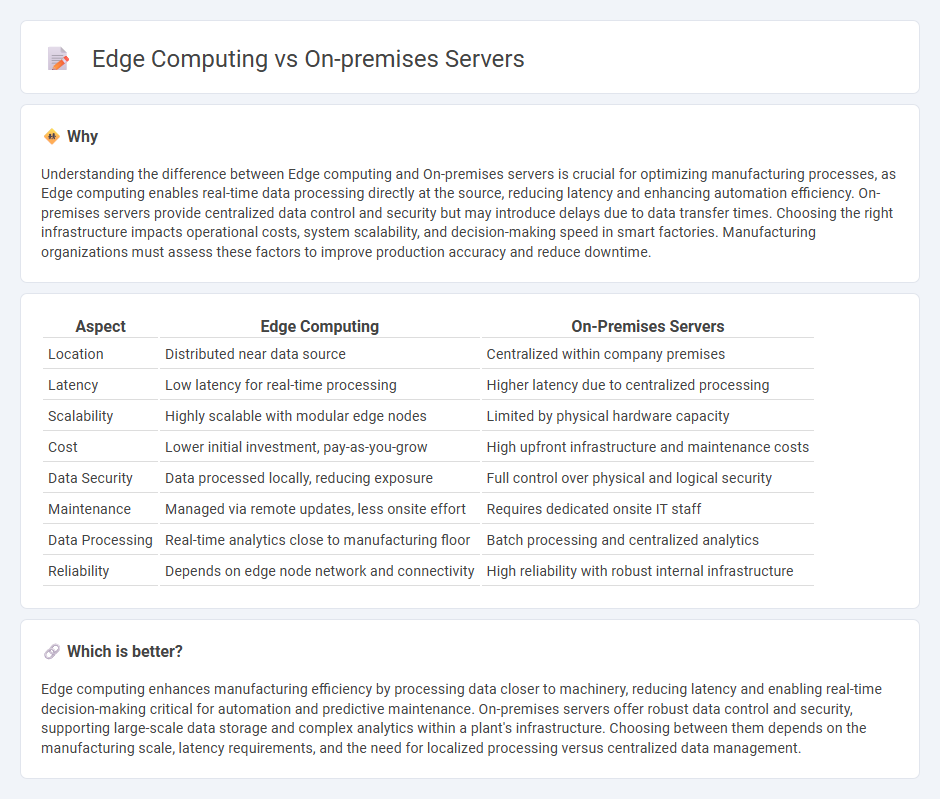
Edge computing processes data near the source, reducing latency and bandwidth use, while on-premises servers provide centralized control and security within a local facility. Manufacturing industries leverage edge computing to enable real-time analytics and predictive maintenance at the production line, whereas on-premises servers support extensive data storage and traditional IT operations. Explore how these technologies can transform manufacturing efficiency and decision-making.
Why it is important
Understanding the difference between Edge computing and On-premises servers is crucial for optimizing manufacturing processes, as Edge computing enables real-time data processing directly at the source, reducing latency and enhancing automation efficiency. On-premises servers provide centralized data control and security but may introduce delays due to data transfer times. Choosing the right infrastructure impacts operational costs, system scalability, and decision-making speed in smart factories. Manufacturing organizations must assess these factors to improve production accuracy and reduce downtime.
Comparison Table
| Aspect | Edge Computing | On-Premises Servers |
|---|---|---|
| Location | Distributed near data source | Centralized within company premises |
| Latency | Low latency for real-time processing | Higher latency due to centralized processing |
| Scalability | Highly scalable with modular edge nodes | Limited by physical hardware capacity |
| Cost | Lower initial investment, pay-as-you-grow | High upfront infrastructure and maintenance costs |
| Data Security | Data processed locally, reducing exposure | Full control over physical and logical security |
| Maintenance | Managed via remote updates, less onsite effort | Requires dedicated onsite IT staff |
| Data Processing | Real-time analytics close to manufacturing floor | Batch processing and centralized analytics |
| Reliability | Depends on edge node network and connectivity | High reliability with robust internal infrastructure |
Which is better?
Edge computing enhances manufacturing efficiency by processing data closer to machinery, reducing latency and enabling real-time decision-making critical for automation and predictive maintenance. On-premises servers offer robust data control and security, supporting large-scale data storage and complex analytics within a plant's infrastructure. Choosing between them depends on the manufacturing scale, latency requirements, and the need for localized processing versus centralized data management.
Connection
Edge computing and on-premises servers are connected through localized data processing and storage, enabling faster decision-making and reducing latency in manufacturing environments. By deploying edge computing alongside on-premises servers, manufacturers can securely analyze real-time data from IoT devices and machinery without relying on distant cloud infrastructure. This hybrid approach enhances operational efficiency, supports predictive maintenance, and improves overall production quality.
Key Terms
Latency
On-premises servers provide control over data and infrastructure but often face higher latency due to centralized processing, impacting real-time applications. Edge computing reduces latency by processing data closer to the source, enhancing performance for IoT devices and time-sensitive workloads. Explore how edge solutions can optimize latency for your specific needs.
Data Security
On-premises servers provide robust data security through physical control and direct management, minimizing exposure to external threats by housing sensitive information within a secured local environment. Edge computing enhances data security by processing data closer to the source, reducing latency and vulnerability during transmission while enabling real-time threat detection and response. Explore the critical differences in data security strategies between on-premises servers and edge computing to determine the best fit for your organization's needs.
Real-time Processing
On-premises servers provide centralized control and robust data management but often face latency challenges in real-time processing due to physical distance from data sources. Edge computing decentralizes data processing by leveraging devices closer to data generation points, significantly reducing latency and enhancing real-time analytics and decision-making capabilities. Explore how integrating edge computing with existing infrastructure can transform your real-time processing strategies.
Source and External Links
On-Premises vs. Cloud - This webpage explains on-premises servers as privately owned and controlled infrastructure, offering full control over data and operations.
Cloud-Based Servers vs. On-Premises Servers - Discusses how on-premises servers are suitable for businesses with unreliable internet connectivity, offering low latency and direct control.
On Premise vs. Cloud - Highlights that on-premises servers require enterprises to handle ongoing costs and maintenance of hardware, power, and space.
 dowidth.com
dowidth.com